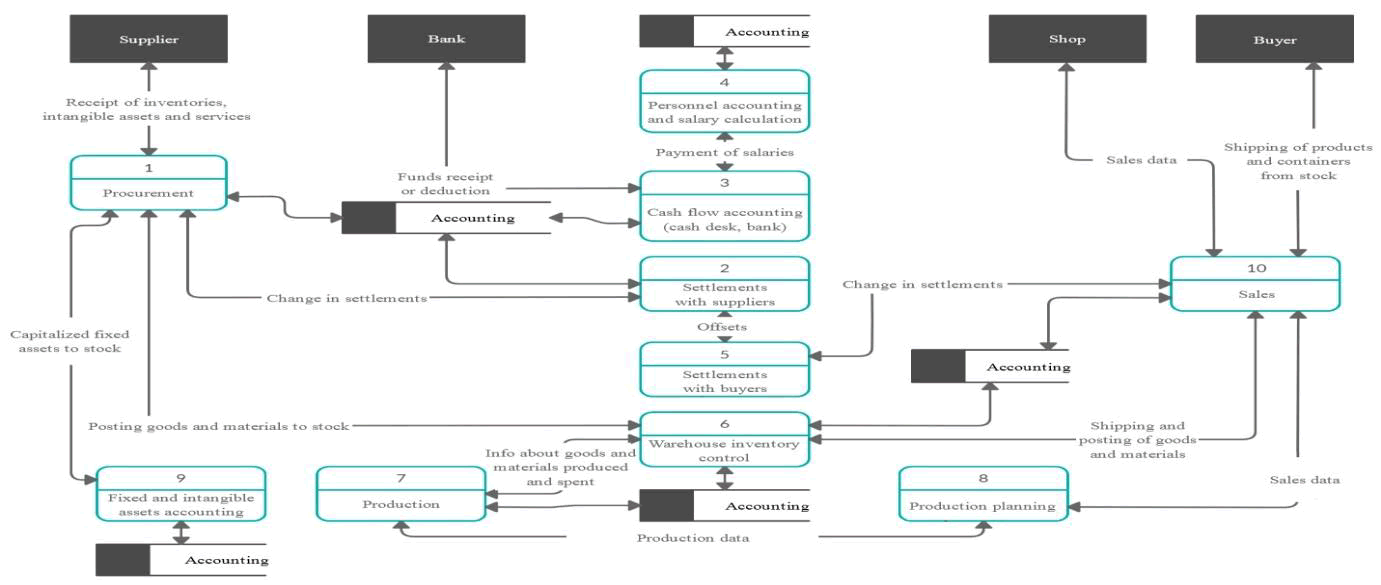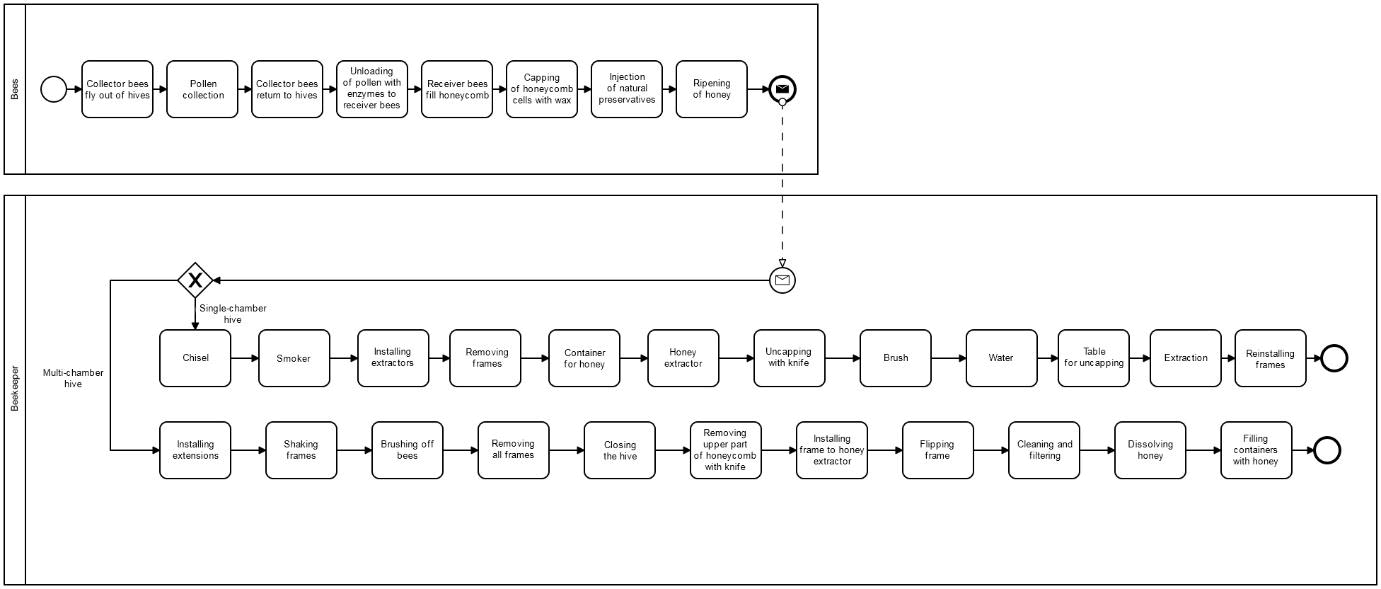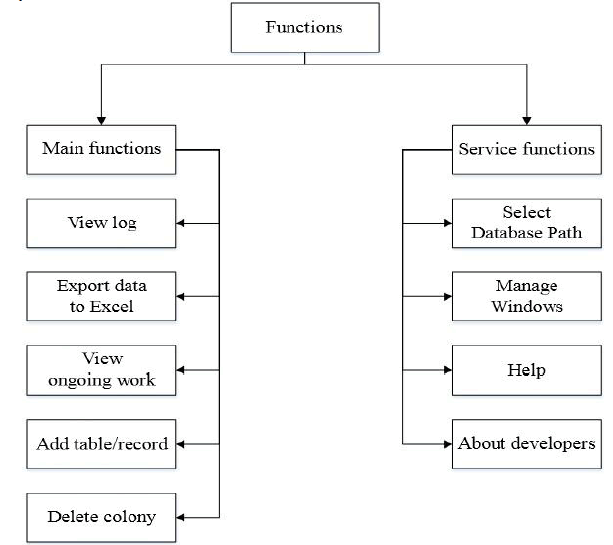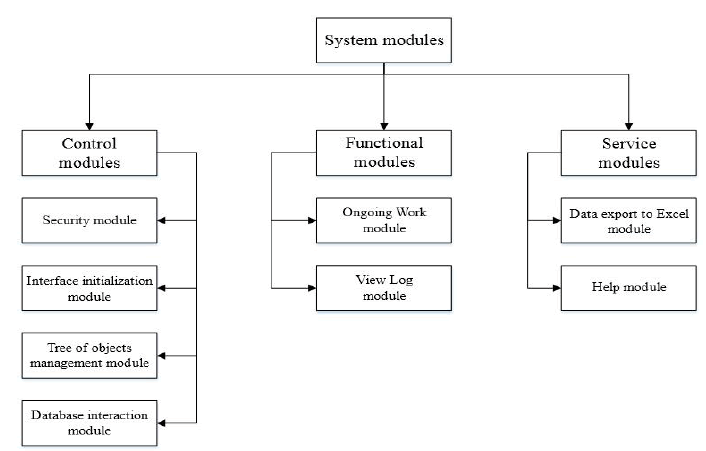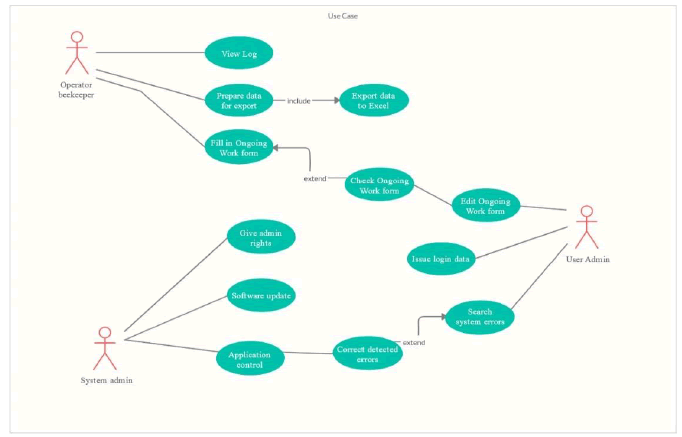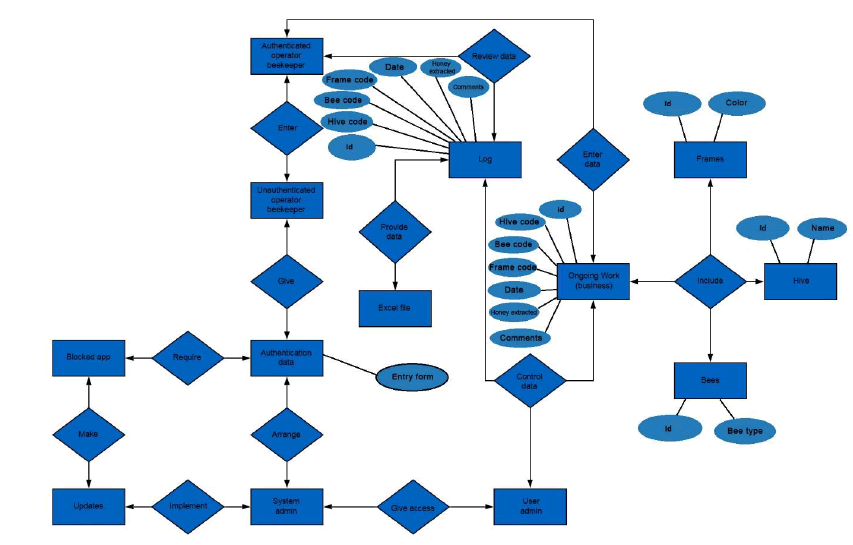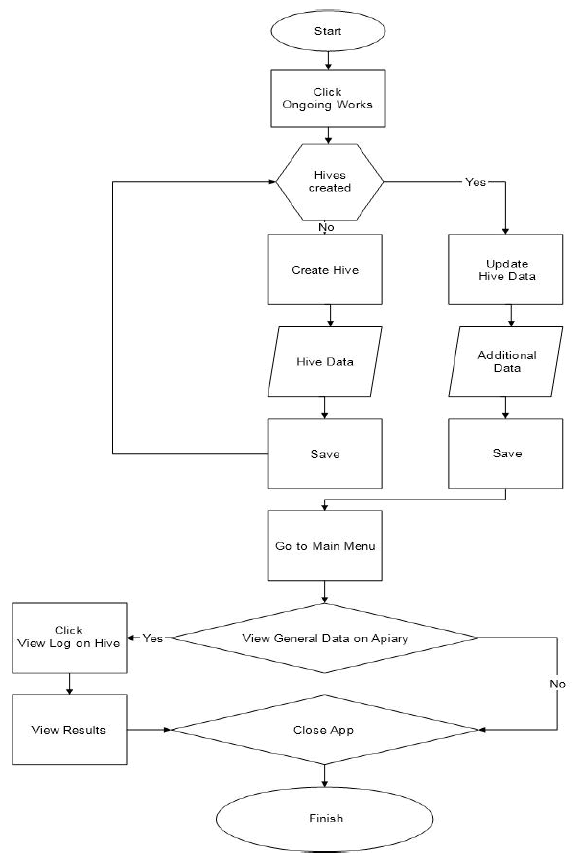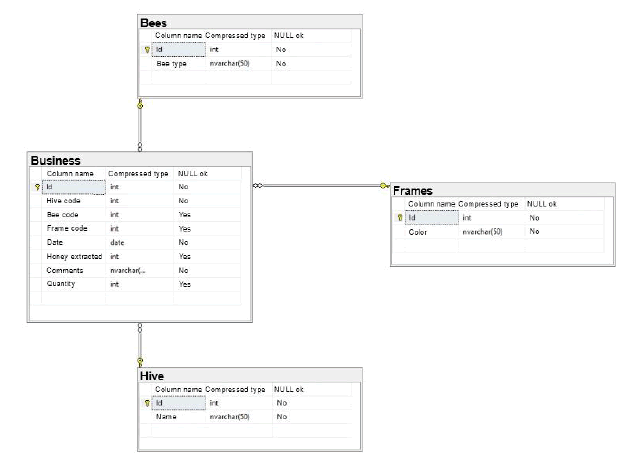Research Article: 2022 Vol: 21 Issue: 2S
Designing an Information System for Apiarian Works Accounting
Mikhail I. Gorbachev, Russian State Agrarian University-Moscow Timiryazev Agricultural Academy
Irina E. Bystrenina, Russian State Agrarian University-Moscow Timiryazev Agricultural Academy
Elena E. Khudyakova, Russian State Agrarian University-Moscow Timiryazev Agricultural Academy
Marina N. Stepantsevich, Russian State Agrarian University-Moscow Timiryazev Agricultural Academy
Mikhail I. Gorbachev, Russian State Agrarian University-Moscow Timiryazev Agricultural Academy
Keywords
Beekeeping, Database, User Form Layouts
Citation Information
Cherevatova, T.F., Bystrenina, I.E., Khudyakova, E.E., Stepantsevich, M.N., & Gorbachev, M.I. (2022). Designing an information system for apiarian works accounting. Academy of Strategic Management Journal, 21(S2), 1-13.
Abstract
The digitalization in agriculture is a pressing issue that requires development and implementation of domestic information systems and IT projects.
Materials and Methods: The Microsoft Visual Studio environment and the C# programming language were used to develop an application for a beekeeping company. The UML language was used to construct diagrams.
Results: An IT project aimed at creating an information system was implemented, including identification of system requirements, and development of user form layouts and use case diagrams. Samples of input and output documents and database models are presented in the article.
Conclusion: Information technology is relevant and purposeful in modern agriculture. As the task of creating an apiarian information system was solved, it confirmed the practical importance of the program application that can be quite useful for enterprises engaged in beekeeping.
Introduction
Beekeeping is an old and quaint feature of farming industry in Russia. Bee products, such as honey, wax, propolis, bee bread, royal jelly and bee venom, have non-reproducible composition, and technological, nutritional and medicinal properties. They have found their application in more than 60 sectors of economy: food manufacturing, consumer goods industry, pharmaceutical industry, medicine, cosmetology, astronautics, military industrial sector, civil construction, architecture and, above all, treatment and prevention of diseases in variously-aged population. Bee products are highly valuable in the domestic and international markets. The most valuable and biologically active product is bee bread—pollen of insect-pollinated plants processed in the bodies of bees.
This highly profitable industry can develop upon condition that the agricultural sector strengthens its market basis and integrates into the world community. The emerging mixed economy in beekeeping is marked by the fact that many traditional organizational structures are supplemented by new forms capable of intensifying production, namely, the latest innovative technology, machinery, equipment, and inventory. Currently, there is an urgent need to search for new methods and opportunities that can make projects successful, bring tangible benefits to farming enterprises, help accumulate big data, and stimulate the deployment of digital innovations in agriculture. And here one cannot do without IT projects (Shokin & Yurchenko, 2018). Therefore, it is necessary to increase the number of Russia-developed information technologies as the problem of digitalization in the national agricultural sector becomes more pressing both at the federal and regional levels. This can be the way to increase the sustainability of production and the competitiveness of Russian products.
It is a relevant task of practical research to improve of the management practices in beekeeping enterprises. For this purpose, it is necessary to create new organizational and legal forms of management, armed with a modern IT infrastructure, on the basis of an integrated and systematic approach to the industry-specific features. Another important aspect is to have assessment methods to measure the performance of such new management techniques (Cherevatova, 2018).
There is a vast amount of literature on beekeeping and bee-breeding published by practicing expert beekeepers, such as Eskov (2018); Zaretsky (2017, 2014, 2012); Zvonarev (2011); Korzh (2015); Korolyov (2015); Shimanovsky (2017). At the same time Russian scientists and specialists, Grekul Denishchenko & Korovkina (2012); Grekul, Korovkina, Levochkina (2019); Ilyushechkin (2015); Karpova (2013); Kirillov (2016); Satunina & Sysoyeva (2009) to name a few—have addressed the scientific, methodological and practical aspects of information system design and database development.
Also, one should refer to normative and regulatory documents that contain the essential theoretical provisions and practical recommendations pertaining to enterprise management [17–23], and international and domestic standards in the field of information technologies and systems that help organize information processes in a rational way [24–30].
Today, IT projects is the main group of design developments implemented at agricultural enterprises. Being based on scientific research and practical experience, such projects introduce elements of information systems, thereby contributing to the use and dissemination of digital technologies, the accumulation of big data and their management, and the introduction of digital innovations in agriculture. This fully applies to beekeeping enterprises.
Using the example of leading beekeeping farms and apiaries of various corporate forms, located in the main beekeeping areas of Russia, experts propose to introduce advanced technologies in the production of beekeeping products. Ryazan Region is a beekeeping area, and Ryazanskaya Pchela JSC, an enterprise from that region, was selected as the object of this research.
The scope of research included automation of the honey production process through the development of additional information systems and software at Ryazanskaya Pchela JSC.
The motivational premise that determined the aim and objectives of this work was the existing needs of the company in the informatization of the functioning facility that operates in the agricultural sector. The aim was to design an information system for accounting for beekeeping works at Ryazanskaya Pchela JSC. The research objectives were:
1. To study the subject area, i.e. beekeeping,
2. To study the regulatory documents pertaining to design and development of information systems,
3. To develop an information system, software for Ryazanskaya Pchela JSC, aiming to introduce automation to the production of beekeeping products and accounting,
4. To summarize the results of the information system development and to outline possible directions for further work.
An apiary must have a sufficiently large and varied melliferous base, consisting of both cultivated and wild plants. To organize and use of the nutritive base correctly, it is important to know honey plants, their honey productivity and methods of reproduction, the period and duration of flowering, and the conditions in which a honey plant grows better and secretes more nectar. It is also crucial to understand the distribution of honey stock within the radius of the productive bee flying during the beekeeping season. In order to establish how many bee colonies can be kept in a certain location, and to get the maximum amount of products from them, it is necessary to assess the area in terms of melliferousness and to study the melliferous base around the apiary.
Materials and Methods
In this work, design and development of the information system were in the focus of attention for it was conceived that the information system should be the main management tool in Ryazanskaya Pchela JSC. In accordance with the modern methodology, the entire process of creating an information system should be linked to the methods, means and technologies for the project implementation and factor in the existing standards (Gvozdeva & Ballod, 2019; Cherevatova, 2020). When designing an information system, the priority should be given to the key tasks, solved by the design methodology, namely:
• To create such an information system that meets the business goals of the company and the requirements of the customer and the users,
• To deliver an information system with given quality, timeframe and budget,
• To maintain, modify and build-up the delivered system.
The proposed information system was designed following the Rapid Application Development (RAD) methodology, which implied (Smirnova, Smirnova, Sorokin & Telnov, 2003):
• Using an iterative (spiral) development model,
• Interacting with the customer and the users of the system,
• Supporting the development and maintenance of the system,
• Optimizing the design resources and reducing the time for development and deployment of the system.
The designed information system must perform operational information processing, maintain the database and ensure the integrity of the data, which include the main input and output data on the company’s activities, and support a conversational mode of interaction with the user. Thus, it creates a unified information environment in the company:
• Ensuring prompt access to the required information,
• Adapting the application,
• Introducing modern effective systems to improve the quality of customer service.
To implement these solutions, it was decided to develop a desktop application for data analysis and processing using the Microsoft Visual Studio integrated environment and the C# language (Johnson, Young & Skibo, 2016; Ziborov, 2013; Kazansky, 2017; Wiegers, 2004; Troelsen, 2015; Fowler, 2011). To create graphical interfaces using the .NET platform, we resorted to Window Forms, an Application Programming Interface (API) that provides a graphical user interface and a part of the Microsoft .NET Framework. This interface simplifies access to the elements of the Microsoft Windows interface by wrapping the existing Win32 API in a managed code. The optimal operating system for the application would be MS Windows 10. MS SQL Server was selected as the data base management system. Data can be queried using a managed programming language such as C# or VB.NET rather than SQL commands. Strongly-typed dataset-oriented queries in .NET languages can easily address ADO.NET (LINQ to SQL), ADO.NET DataSets (LINQ to DataSets), ADO.NET Entity Framework (LINQ to Entities), and to the Entity Data Service Mapping provider. The new LINQ to SQL provider allows direct access to SQL Server tables and columns through LINQ (Ilyushechkin, 2015; Karpova, 2013; Kirillov, 2016; Kostin & Shangin, 2014)
The ADO.NET Object Services layer enables materialization, change tracking, and saving of data as CLR objects. With the ADO.NET framework, one can program the database in terms of such ADO.NET-managed objects. The SQL Server supports this technology more efficiently, which improved productivity and simplified the development.
The basic software must meet the following requirements:
• It is versatile,
• The programming language supports the object-oriented approach to programming;
• There is a compiler for the programming language for the selected system-wide software.
A user should be able to perform the following operations:
• To have tools for control and monitoring of products, conditions and quantity,
• To draw production plans and schedules based on the results of the program;
• To automate pricing based on costs and labor accounting;
To provide the necessary functionality of the system, i.e. to respond correctly to changes in the operating conditions and to ensure easy, uninterrupted operation.
When designing the application, it was important to choose the most appropriate user interface model, as this would affect the deployment process, how users interact with data, and how the current state is maintained throughout the application-user dialogue. The most common user interface models are the standard Windows interface and the Web interface.
The standard Windows interface is used when it is required to provide users with offline mode and rich system functionality; also, it enables efficient state management and data persistence, and gives all the benefits of local data processing. As for the Web interface, in Microsoft .NET, the Web user interface is developed by means of ASP.NET. This technology provides a rich environment for building complex Web interfaces. Let us mention just a few of the ASP.NET features:
• A unified development environment,
• Data binding to the user interface,
• A component-based interface with controls,
• A built-in .NET framework security model,
• Ample opportunities to support caching and state management,
• Availability, performance and scalability of Web data processing.
Therefore, we chose the model the Web user interface for this project.
The organization of the automated system design process met the national standard requirements for such project activities as per GOST R 54869-2011 Project management. Requirements for project management [44].
Results
Ryazanskaya Pchela JSC engages in beekeeping, honey harvesting and selling bee products, such as pollen, bee bread, chitin, comb capping, bee venom, propolis, royal jelly and wax. The company’s distribution channels are retail chains, dealers and wholesale networks.
To implement management functions, we drew the data flow diagram (DFD) that presents the workflow and information processing in the company (Grekul, Korovkina, Levochkina, 2019; Zatonskiy, 2014); refer to Figure 1.
In Ryazanskaya Pchela JSC, the business process is a single large sequence called ‘honey extraction’. It includes:
• Collection of honey by collecting bees,
• Tamping and conservation of honey, ropening of honey,
• Extraction of honey by smoking the hive, uncapping the honeycomb and removing honey from the honeycomb to the containers,
• Removing honey by a mechanical honey extractor,
• Cleaning and filtration of honey, filling the containers with honey.
The main participants in the business process can be divided into two groups:
• Bees, including collector bees and receiver bees,
• Beekeepers, including all employees who come into contact with the hives.
The main business process implements the main function of the apiary, i.e. harvesting and selling honey. It includes all processes related to the production of honey, neutralization of bees, extraction of honey, filling the containers.
Figure 2 shows a model of the main business process Honey Extraction and Sale (Grekul, Korovkina, Levochkina, 2019; Abdikeyev & Kitova, 2012; Blinov, 2013). The result of this business process is the extracted honey that can be used in production and sold.
In our opinion, the most significant drawbacks in the company operation were the following ones:
• The company did not work with large volumes of bee products, although customers would want that,
• There was no well-established system for tracking the delivery of honey, bees and other equipment; there are problems with the introduction of documentation,
• There was no system of incentives and motivation for the personnel to comply with the designated standards,
• It took a rather long time to analyze and prepare commercial proposals.
As part of this work, we made recommendations how to eliminate or mitigate these drawbacks. It was proposed to design an information system that would:
• Facilitate working with large volumes of bee products and establish a well-functioning delivery tracking system for customer orders,
• Shorten the period for processing commercial proposals by speeding up the process of calculating the manufactured product cost, based on the costs of materials and labor costs.
The developed application was designed to automate the production management and the information processing. Hence it must be able to perform the following functions:
• Working with the company’s database,
• Introduction and review of ongoing activities (adding tables and records, setting their parameters and comments, deleting information about bees and apiaries),
• Viewing the work log (viewing the dates, the number of frames, the amount of extracted honey by selecting a bee colony),
• Exporting the work log data to Excel (.xls) formats.
With these functions, it is possible to maintain the accounting of bee colonies and accumulate information on the apiaries, which contributes to the data automation in Ryazanskaya Pchela JSC. The developed application can automate such activities as data processing and preparation of documents about the apiary.
There are two subsets of program functions (Figure 3):
• Service functions,
• Main data processing functions.
In the main menu we placed the service functions: Select Database Path, Manage Windows (Select Log), Help, About Developers. The main functions can be summoned from the keypad. The ‘tree of objects’ for this function can be opened on the screen by pressing one of the keys.
The proposed system has three groups of software modules (Figure 4):
1) Control modules that manage the system objects,
2) Functional modules that provide for viewing, entering and processing of data (Fowler, 2011)
3) Service modules that provide for additional services.
Next, it was necessary to provide a script for using the system, which is a sequence of steps that describe the user’s actions and the system’s response to them. Figure 5 shows the script the Apiarian Works Accounting: this program allows beekeepers to view all relevant data on apiaries and update them (Grekul, Korovkina, Levochkina, 2019; Zatonskiy, 2014 )
The proposed system three actors: a beekeeper operator who enters and views system data; a user administrator who controls data entry, searches for software errors and issues login data; and a system administrator who gives the user administrator rights, modifies and fixes software errors. The main functional requirements for a PC were to provide the operator with the ability to view data and enter new data into the system.
To display the subject area for which the database was developed, it was necessary to build a conceptual model (Zatonskiy, 2014; Trofimov, 2012; Kalyanov, 2017); refer to Figure 6.
The logical model was built on the basis of the IDEF1X methodology. This is an Entity – Relationship approach to data modeling proposed by Peter Chen in 1976. IDEF1X is focused on the design of relational database models (Kalyanov, 2017)
The Apiarian Works Accounting program, linked to the database, must provide the following data processing functions:
• Adding and deleting information about apiaries, including id, hive code, bee code, frame code, date, extracted honey, and comments in the form of ongoing works,
• Viewing information about apiaries, including id, hive code, bee code, frame code, date, extracted honey, comments in the form of work logs,
• Carrying out operations of grouping the bee colonies, and viewing a complete list of information about a given colony in the hive.
• Presenting information as Excel tables in real-time mode.
The normative and reference information of the program is given in reference books on frames, hives and bees, which help an employee to navigate the forms.
The source documents for goods and sales accounting were:
• The primary accounting documentation form (agricultural products receipt diary – Form No. SP-14) – hardcopy or softcopy documents evidencing any business or financial transactions, i.e. important accounting documents used for the preparation, verification and audit of the company’s financial statements; such document must bear the date they have been issued on,
• Inventory documents – the documents pertaining to checking the availability of the company’s property and the state of its financial obligations for a certain date by comparing the actual data with the accounting data; such document must bear the date they have been issued on.
Tables 1–3 show the samples of input documents.
| Table 1 Database Input Document (Frames Table) |
|
|---|---|
| Frames table | Type |
| Id | Int |
| Color | varchar |
| Table 2 Database Input Document (Hive Table) |
|
|---|---|
| Hive table | Type |
| Id | Int |
| Name | varchar |
| Table 3 Database Input Document (Bees Table) |
|
|---|---|
| Bees table | Type |
| Id | Int |
| Bee_type | Varchar |
Table 4 shows how the output data is presented.
| Table 4 Database Output Document For The Business Table |
|
|---|---|
| Business table | Type |
| Id | Int |
| Hive code | Int |
| Bee code | Int |
| Frame code | Int |
| Date | Date |
| Extracted honey | Int |
| Comments | Int |
The report generated the work log contains the serial number, hive code, bee code, frame code, date, information on the extracted honey and comments from the beekeeper operator.
Information processing consists in obtaining some ‘information objects’ from other ‘information object’ by performing certain algorithms. Information processing is one of the main activities involving information, and the main means of increasing its scope and variety. The application uses the data processing algorithm presented in Figure 7. Let us describe the data processing sequence clearly:
Start the application and click on the Ongoing Works button. Next, the user goes to a new form, where records about a hive can be made. Add comments about the added hive records if needed. Having made the records about a hive, the user can exit the application or return to the menu and click View Log to view the information about the entire apiary. There is no other function intended for the users and the application can be closed until the next use.
We built a physical model of the database according to the methodology by (Smirnova, Smirnova, Sorokin, Telnov, 2003; Trofimov, 2012; Kalyanov, 2017). It was implemented in the Microsoft SQL Server DBMS in the Management Studio SQL Server 18.5 program. Each table has a name, primary and secondary keys, and relationships between tables. Each column has a name, data type, and zero tolerance. The physical model of our database is similar to the logical one (Figure 8).
Discussion
The experience has shown that deployment of automated information systems for the accounting of apiary works allows for an optimal approach to processing operational information in beekeeping companies.
Despite the relevance and importance of information technology in modern agriculture, many agricultural organizations that produce beekeeping products lack means for its acquisition and implementation. The proposed solution to this problem confirmed the practical importance of the apiary management application in Ryazanskaya Pchela JSC. The developed software will be useful to similar agroindustrial enterprises.
Conclusion
The work has achieved the goal of studying the methods and tools of the project, as well as their application. The art of beekeeping was studied and the business processes in Ryazanskaya Pchela JSC were investigated.
The search showed that there are no analogues to the developed application in the market. Having studied the theoretical aspects of beekeeping industry, the regulatory framework for the information system design and the company’s operations, it was decided to develop an information system for accounting apiary products and works. The requirements for the information system were identified. The basic layouts of user forms were developed, and the diagram of the system scenarios were given.
The developed software allows grouping and controlling the works in the apiary, such as planning, accounting of the performed work and analysis of the current state of the apiary.
The application of the information system should provide Ryazanskaya Pchela JSC with a more coordinated, faster work and careful control of honey production resources.
It is expected that as a result of this work:
1) The company will be able to obtain relevant data on the beekeeping process,
2) The company will operate a ready-made program that stores and analyzes apiarian data, maintains all the basic and necessary information about the company’s beekeeping activities, including information about hives, colonies, honeycomb frames, types of bees and their interaction in general.
References
Shokin, Y.I., & Yurchenko, A.V. (2018). Rol informatsionnykh tekhnologiy v nauke. Razvitiye IT-servisov dlya sovremennykh nauchnykh issledovaniy [The information technologies value for science. The development of it services for modern scientific research]. Information technologies, Systems and Devices in the Agro-Industrial Complex: Proceedings of the 7th International Scientific and Practical Conference "Agroinfo-2018", Krasnoobsk, Russia, 24–25 October 2018. Krasnoobsk, Siberian Federal Scientific Center of Agrobiotechnology of the Russian Academy of Sciences, Siberian Institute of Physics and Technology of Agrarian Problems, pp. 14–22. (in Russian)
Cherevatova, T. F. (2018). IT-infrastruktura organizatsii [IT-infrastructure of Organization]. Moscow, FGBNU Rosinformagrotekh. (in Russian)
Yeskov, Y.K. (2018). Mikroklimat pchelinogo zhilishcha [Microclimate of a Bee House]. Moscow: Rosselkhozizdat. (in Russian)
Zaretsky, N.N. (2017). Posobiye dlya nachinayushchego pchelovoda [The Beginner Beekeeper’s Guide]. Moscow: Moskovskiy Rabochiy. (in Russian)
Zaretsky, N.N. (2014). Priusadebnaya paseka [Homestead Bee Garden]. Moscow, Niva Rossii, 2014. (in Russian)
Zaretsky, N.N. (2012). Ukhod za pchelami [Honey Bee Management]. Moscow, Kniga Po Trebovaniyu. (in Russian)
Zvonarev, N.M. (2011). Azbuka effektivnogo pchelovodstva. Organizatsiya paseki. Soderzhaniye, razvedeniye, bolezni pchel. Produkty pchelovodstva [An ABC Book of Efficient Beekeeping. Bee Garden Management. Bee Farming, Bee Breeding and Bee Diseases. Honey Products]. Moscow, Tsentrpoligraf. (in Russian)
Korzh, V.N. (2015). Spravochnik pchelovoda-praktika [The Practical Beekeeper’s Handbook]. Moscow, Feniks. (in Russian)
Korolyov, V. (2015). Pchelovodstvo. Pervyye shagi k pribylnomu khozyaystvu [Beekeeping. The First Steps to Profitable Farm]. Moscow, Eksmo. (in Russian)
Shimanovsky, V.Y. (2017). Metody pchelovozhdeniya [A Beekeeping Method]. Moscow, Moskovskiye Uchebniki i Kartolitografiya. (in Russian)
Grekul, V.I., Denishchenko, G.N., & Korovkina, N.L. (2012). Upravleniye vnedreniyem informatsionnykh system [Management of Information System Deployment]. Moscow, Internet-Universitet Informatsionnykh Tekhnologiy; BINOM. Laboratoriya znaniy. (in Russian)
Grekul, V.I., Korovkina, N.L., & Levochkina, G.A. (2019). Proyektirovaniye informatsionnykh sistem: uchebnik i praktikum dlya akademicheskogo bakalavriata [Designing Information Systems: Textbook and Workshop for Academic Bachelor’s Degree]. Moscow, Urait. (in Russian)
Ilyushechkin, V.M. (2015). Osnovy ispolzovaniya i proyektirovaniya baz dannykh [Fundamentals of using and designing databases]. Moscow, Urait.
Karpova, I.P. (2013). Bazy dannykh [Databases]. Moscow, Piter. (In Russian)
Kirillov, V.V. (2016). Vvedeniye v relyatsionnyye bazy dannykh [Introduction to relational databases]. Moscow, BKHV-Peterburg. (in Russian)
Satunina, A.Y., & Sysoyeva, L.A. (2009). Upravleniye proyektom korporativnoy informatsionnoy sistemy predpriyatiya [Management of Corporate Information System Projects]. Moscow, Finansy i Statistika; INFRA-M. (in Russian)
GOST 20740-75 Beehives. Specifications.
GOST 21179-2000 Beewax. Specifications.
GOST 21180-2012 Honeycomb foundation. Specifications.
GOST 28886-90 Propolis. Specifications.
GOST 28888-2017 Royal jelly. Specifications.
GOST 31775-2012 Wax raw material. Specifications.
GOST 31776-2012 Beebread. Specifications.
GOST R ISO/IEC 12207-2010 Information technology. System and software engineering. Software life cycle processes.
GOST R ISO/IEC 25040-2014 Information technology. System and software engineering. System and software quality requirements and evaluation (SQuaRE). Evaluation process.
GOST 34.003-90 Information technology. Set of standards for automated systems. Automated systems. Terms and definitions.
GOST 34.601-90 Information technology. Set of standards for automated systems. Stages of development.
RD 50-34.698-90 Automated systems. Document content requirement.
GOST 19.105-78 United system for program documentation. General requirement for program documents.
GOST 19.101-77 United system for program documentation. Types of programs and program documents.
Gvozdeva, T.V., & Ballod, B.A. (2019). Proyektirovaniye informatsionnykh sistem. Standartizatsiya [Designing Information Systems. Standardization]. Saint Petersburg, Lan. (in Russian)
Cherevatova, T.F. (2020). Normativnoye obespecheniye v sfere informatsionnykh tekhnologiy i sistem [Regulatory Support in the Field of Information Technology and Systems]. Moscow, NITS MISI. (in Russian)
Smirnova, G.N., Smirnova, G.N., Sorokin, A.A., & Telnov, Y.F. (2003). Proyektirovaniye ekonomicheskikh informatsionnykh sistem [Designing Economic Information Systems]. Moscow, Finansy i Statistika. (in Russian)
Zatonskiy, A.V. (2014). Informatsionnyye tekhnologii: razrabotka informatsionnykh modeley i sistem [Information Technology: Development of Information Models and Systems]. Moscow, RIOR: INFRA-M. (in Russian)
Abdikeyev, N.M., & Kitova O.V., eds. (2012). Korporativnyye informatsionnyye sistemy upravleniya [Corporate Information Management Systems]. Moscow, INFRA-M. (in Russian)
Blinov, A.O., ed. (2013). Reinzhiniring biznes-protsessov [Reengineering of Business Processes]. Moscow, YUNITI-DANA. (in Russian)
Johnson, B., Young, M., & Skibo, C. (2016). Inside Microsoft visual studio.NET 2003, Russian Edition. Moscow, Russkaya Redaktsiya. (in Russian)
Ziborov, V.V. (2013). Visual C# 2012 na primerakh [Visual C# 2012 in examples]. Moscow, BKHV-Peterburg. (in Russian)
Kazansky, A.A. (2017). Obyektno-oriyentirovannoye programmirovaniye na yazyke Microsoft Visual C# v srede razrabotki Microsoft Visual Studio 2008 i .NET Framework [Object-oriented programming in Microsoft Visual C# in the Microsoft Visual Studio 2008 development environment and .NET Framework], Vol 3. Moscow, MGSU. (in Russian)
Wiegers, K.E. (2004). Software Requirements, Russian Edition. Moscow, Russkaya Redaktsiya. (in Russian)
Troelsen, A. (2015). Pro C# 5.0 and the .NET 4.5 Platform, Russian Edition. Moscow, Williams. (in Russian)
Fowler, M. (2011). UML Distilled. A Brief Guide to the Standard Object Modeling Language, Russian Edition. Moscow, SINTEG. (in Russian)
Kostin, A.Y., & Shangin, V.F. (2014). Organizatsiya i obrabotka struktur dannykh v vychislitelnykh sistemakh [Organization and Processing of Data Structures in Computing Systems]. Moscow, Vysshaya shkola. (in Russian)
GOST R 54869-2011 Project management. Requirements for project management.
Fowler, M. (2011). UML Distilled. A Brief Guide to the Standard Object Modeling Language, Russian Edition. Moscow, SINTEG. (in Russian)
Trofimov, V.V., ed. (2012). Informatsionnyye sistemy i tekhnologii v ekonomike i upravlenii: uchebnik dlya bakalavrov [Information Systems and Technologies in Economics and Management: A Textbook for Bachelor’s Degree Studies], 3rd edition. Moscow, Urait. (in Russian)
Kalyanov, G.N., ed. (2017). Strategicheskoye upravleniye informatsionnymi sistemami [Strategic management of information systems]. Moscow, Internet-Universitet Informatsionnykh tekhnologiy: BINOM. Laboratoriya znaniy. (in Russian)
Received: 23-Nov-2021, Manuscript No. asmj-21-9230; Editor assigned: 25- Nov -2021, PreQC No. asmj-21-9230 (PQ); Reviewed: 30- Nov -2021, QC No. asmj-21-9230; Revised: 11-Dec-2021, Manuscript No. asmj-21-9230 (R); Published: 05-Jan-2022
